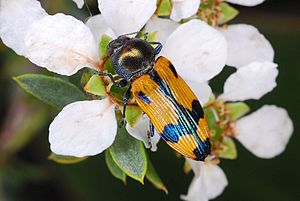Castiarina allensundholmi facts for kids
Quick facts for kids Castiarina allensundholmi |
|
|---|---|
 |
|
| Adult on the flowers of a Leptospermum sp., Goobang Range, New South Wales, Australia | |
| Scientific classification | |
| Genus: |
Castiarina
|
| Species: |
allensundholmi
|
Castiarina allensundholmi is a beautiful type of beetle. It belongs to a family called Buprestidae, also known as jewel beetles. These beetles often have shiny, metallic colors. Dr. Shelley Barker discovered this species in October 2003. She officially described it in 2005.
The first three beetles found were between 7 and 8.2 millimeters long. That's about the size of a small button! This beetle is part of a group called the Castiarina balteata species group. This group includes three similar-sized species.
Contents
What's in a Name?
Why is it Called Castiarina allensundholmi?
This beetle was named after Allen Michael Sundholm. He is an entomologist, which means someone who studies insects. Allen was also one of the people who first found this beetle.
He received a special award, the Medal of the Order of Australia (OAM). This was for his important work in the early 1980s. He helped save a huge area of natural land in Western Australia. This area is now known as the Great Western Woodlands. It is rich in different plants and animals.
Where Do They Live?
Geographic Distribution
As of October 2015, this beetle has only been found in two places. Both locations are in New South Wales, Australia.
The first three beetles were found in October 2003. This was west of Euabalong West, in the Lachlan Plains. Twelve years later, in October 2015, Allen Michael Sundholm found two more. These were in the Goobang Range. This new discovery showed the beetle lives 200 kilometers further east.
Scientists think the beetle might live in more places. However, more fieldwork is needed to confirm this. Even with a lot of searching, no more beetles have been found west of Euabalong West. This suggests that Euabalong West might be the western edge of their habitat.
How High Do They Live?
The first beetles were found at an average height of 170 meters above sea level. The beetles found in the Goobang Range were at 565 meters above sea level.
When Are They Active?
All five known adult beetles were found in October. This was from early to late October. The exact time they appear can change each year. This depends on natural weather changes, like how much rain there has been.
Where Do They Like to Live?
What Kind of Habitat?
The Euabalong West site is a special area. It's a mix of two types of habitats. To the west, there are endangered mallee habitats. To the east, there are endangered woodlands. Some of these mallee areas are protected in nature reserves.
The Goobang Range area is an open woodland. It has many Callitris endlicheri trees, also known as Black Cypress Pine. Some parts of the Goobang Range are protected inside Goobang National Park.
What Do We Know About Their Lives?
Early Life Stages
Not much is known about the early life of Castiarina allensundholmi. This includes their eggs, larvae (young beetles), and pupae. We also don't know what plants their larvae eat. It's also a mystery how long it takes for them to grow from egg to adult.
Knowing what plants the larvae eat would help scientists. It would help them understand where these beetles can live. Unfortunately, there isn't much funding for this kind of research in Australia.
Adult Beetles
The five adult beetles found were on flowers. Some were on Micromyrtus sessilis flowers near Euabalong West. Others were on an unknown type of Leptospermum flower in the Goobang Range.
Like other Castiarina beetles, adults likely eat nectar from flowers. They might also nibble on the petals. Environmental factors, like drought or rain, can affect when adults appear. They might stop emerging or start growing into adults depending on the weather.
What Dangers Do They Face?
Losing Their Homes
The two known places where these beetles live have lost a lot of natural habitat. This has happened since people settled in Australia. If more land is cleared, especially in these two areas, it could harm the beetles. Neither of these places is currently protected in a nature reserve.
Climate Change
No specific studies have looked at how climate change affects this beetle. However, if the climate changes too quickly, it could be very bad for them. They might not be able to survive if the weather becomes too different from what they are used to.
- Barker, S., 2006: Castiarina: Australia's richest jewel beetle genus. Australian Biological Resources Study, 2006, vi + 341pp, 46 plates. ISBN: 9780642568434

